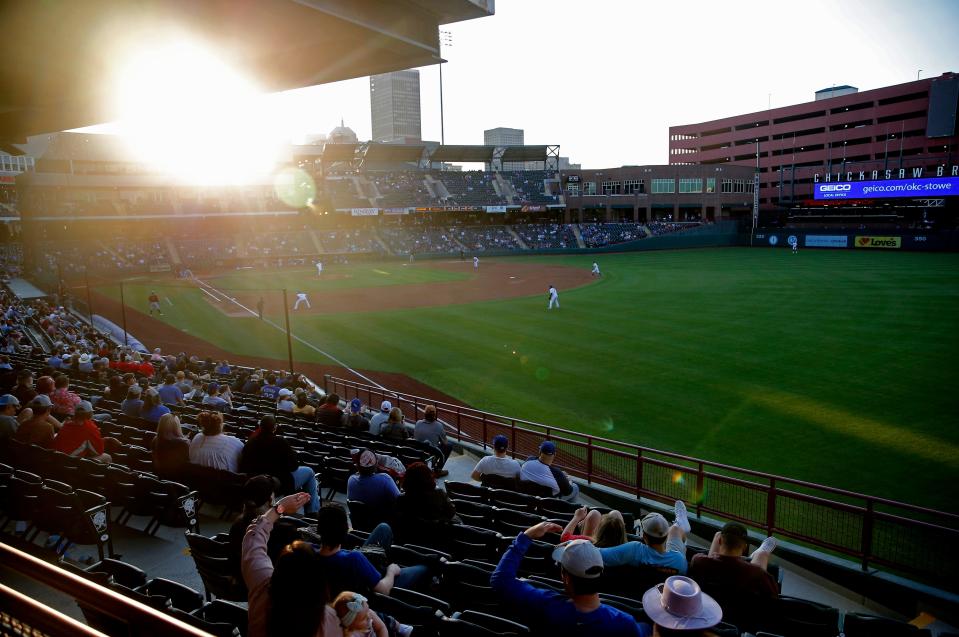Tramel: As Bricktown Ballpark turns 25, it remains a monument to a city that bet on itself
Tim O’Toole was having a busy day.
A new ballpark to open. Dignitaries in town, including the 1950s-60s New York Yankees, who arrived to honor their old pal Mickey Mantle. Civic functions before and after the opening pitch.
O’Toole was caught upstairs, in the new luxury suites of Bricktown Ballpark, before the game and didn’t get a break until the second or third inning. The Oklahoma RedHawks general manager finally scurried down the stairs and onto the concourse.
O’Toole still remembers what he saw 25 years ago Sunday, April 16, 1998.
“I could not believe how people were walking around with smiles on their faces, and a constant flow of traffic all around the ballpark,” O’Toole said. “They wanted to take it all in.
“Obviously the stands were full, too. But the activity was constant all night long. It was about as positive a vibe as I’ve ever experienced.”
Happy birthday to The Brick. The first completion of the Metropolitan Area Projects Plans, MAPS, which has transformed the city in the 30 years since it and succeeding 1-cent sales tax votes have invigorated Oklahoma City in ways unimaginable even to the most optimistic of city fathers.
More: Thunder report card: OKC has no answer for Karl-Anthony Towns in loss to Timberwolves

Bricktown Ballpark was a hit right from the start
Twenty-five years ago Sunday, Bricktown Ballpark opened, and citizens got a rush of belief. Look what we’ve built. Look what we’ve done.
The OKC transformation — the canal that meanders through Bricktown and the creation of a riverfront, both of which have lured visitors for decades; the arena that eventually brought the NBA; the new downtown library and the refurbished Civic Center Music Hall and the expanded convention center, plus all the later MAPS projects that enhanced the city and schools — began with a baseball stadium that dropped the jaws of locals and impressed visitors.
“It truly was a confidence builder,” said John Allgood, now a professor in Temple University’s renowned sports business program but then the RedHawks’ public relations director. “When it finally got built, it gave confidence to the citizens of Oklahoma City that MAPS could work and would work.”
The initial MAPS vote came in 1993, and it passed by 5,605 votes. But the 1995 Murrah Building bombing put everything on hold. Revitalizing a city takes a backseat to burying bodies and mourning 168 lives.
The delays in construction, the nature of the sales tax and Oklahoma’s conservative bent created skepticism.
“MAPS hadn’t really gained any momentum,” O’Toole said. “‘Is this another taxpayer boondoggle?’ And we all felt that pressure.”
Then the ballpark opened, and everyone said, “Wow.”
O’Toole still recalls the April visit of Baltimore Sun reporter Jon Morgan, in town to do a major story on OKC’s rise from the ashes of the bombing.
O’Toole gave Morgan a ballpark tour.
"I’ll never forget that guy,” O’Toole said.
“‘You know, this place is really nice,’” Morgan told him. “‘You’ve got yourself a little jewel, a little Camden Yards. I’m not blowing smoke. Reporters from the East Coast, we’re not known for saying nice things. This is really nice.’”
The canal would open in 1999, to much acclaim. But the arena and the virtually-new Civic Center didn’t open until 2001. The new library not until 2004.
More: Tramel's ScissorTales: OU softball radio voice Chris Plank swept up in Sooner phenomenon
Bricktown Ballpark was part of first MAPS project
The second MAPS vote, befitting schools, passed by a huge margin in 2001. Citizens, having seen the ballpark and the canal, green-lit future projects, including votes in 2009 and 2019.
Bricktown Ballpark paved the way.
Old-timers will remember the desolation of downtown Oklahoma City. No activity after 5 p.m. Bricktown was mostly-deserted, Depression-era buildings.
But Spaghetti Warehouse opened in Bricktown in 1989 and became a sensation. O’Briens piano bar opened in 1990. Bricktown had a pulse.
Then here came the ballpark, with its brick façade that perfectly fit the Bricktown motif. The envisioned entertainment district took off. In the 1980s, OKC had one downtown hotel. Today, there are a dozen in Bricktown alone.
“Showed that ballparks that are publicly funded facilities spur economic development,” Allgood said.
Architect Tom Wilson of Oklahoma City firm ADG not only designed a stadium that fit the district but was designed with fans in mind.
“Spacious concourses,” Allgood said. “I remember Tom Wilson telling me this — he wanted to make sure you could see, from anywhere on the concourse, the field.
"They just did a really good job of designing it. What people were excited about was not just how it fit in but how comfortable they felt inside the ballpark, feeling space.”
The ballpark remains a jewel, now for the Oklahoma City Dodgers. It’s showing a little age but has been spruced up and underwent some renovation this off-season.
Still a little Camden Yards. And a monument to a city that bet on itself.
Berry Tramel: Berry can be reached at 405-760-8080 or at btramel@oklahoman.com. He can be heard Monday through Friday from 4:40-5:20 p.m. on The Sports Animal radio network, including FM-98.1. Support his work and that of other Oklahoman journalists by purchasing a digital subscription today.
More: Tramel's ScissorTales: Why OSU's Mike Gundy sees similarities in Bryan Nardo, Gary Gibbs
This article originally appeared on Oklahoman: Bricktown Ballpark a monument to Oklahoma City's bet on itself

